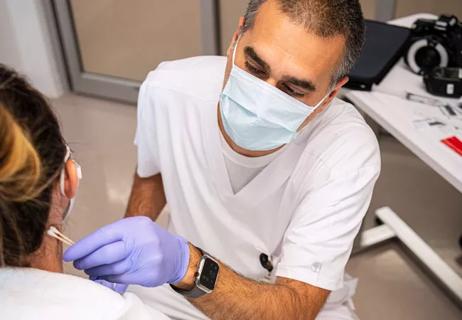‘My Safety Plan’ uses teach-back method

In 2014, nurses on a cardiothoracic step-down unit at Cleveland Clinic’s main campus set out to decrease patient falls. The unit had a fall rate of 2.78 per 1,000 patients, below the National Database of Nursing Quality Indicators’ step-down benchmark of 3.46 per 1,000 patients. But the dedicated caregivers believed they could improve.
Cleveland Clinic is a non-profit academic medical center. Advertising on our site helps support our mission. We do not endorse non-Cleveland Clinic products or services. Policy
“Nurses were doing all the standard interventions – educating patients, placing armbands and yellow socks on at-risk patients, using bed alarms and so on,” says Jennifer Colwill, MSN, APRN, CCNS, PCCN, a clinical nurse specialist in Cleveland Clinic’s Sydell and Arnold Miller Family Heart & Vascular Institute. “We were beneath the benchmark, but remained at status quo. That led to an intervention.” The unit developed My Safety Plan, a patient falls prevention education tool.
An advanced practice nursing student helped conduct a prospective review of patient, nurse and environmental factors using a survey tool developed by Colwill and Kelly Haight, MSN, APRN, ACNS-BC, PCCN, another clinical nurse specialist. The review revealed a gap in nursing practice and patient education. Although 100 percent of surveyed patients had documentation in the electronic medical record indicating that they viewed the fall prevention safety video, only 75 percent of those patients recalled seeing the video and less than 30 percent remembered specific information regarding fall prevention, such as risks for falling and expected safety behaviors.
Based on the findings, the unit proposed using teach-back methodology to promote patient understanding of individual fall risks and safety. Colwill teamed with Nurse Manager Terri Murray, MSN, RN, NEA-BC, and other staff members to create My Safety Plan.
“The literature says that patient education is ineffective when patients do not comprehend or remember what was taught,” says Colwill. “A good rule of thumb is keeping it simple and bundling patient education in groups of three. Then patients are more apt to remember things.” My Safety Plan is a one-page tool, posted in patient rooms and reviewed at every shift change, that includes three sections:
The step-down unit participated in a six-week pilot of the new education process in the spring of 2015. Michelle Chaffin, BSN, RN, PCCN, an assistant nurse manager on the unit, was instrumental in implementation of the pilot. The initial step was assessment of patient readiness to learn. When patients were admitted to the step-down unit, most often via transfer from the ICU, nurses first considered, “Is my patient ready to learn?” Patients who are sleepy, anxious or in pain may not be ready to receive information on falls.
Next, nurses played a falls video. Afterward, the nurse, patient and family completed the first section of the My Safety Plan tool using the teach-back methodology. They filled in individual reasons they were at risk for falls, such as medications they were taking or procedures they had undergone. “During the pilot, we empowered patients to fill out much of the tool by themselves,” says Colwill. “It’s important for patients to have ownership in the education process and their subsequent care.”
The second section of the tool includes steps the patient will take to be safe: remain sitting or in bed, press the call light for help, wait for help to arrive and once help has arrived, change positions slowly. The third section highlights actions that nurses will take to keep the patient safe: respond to the call light for help, check in on the patient every hour during the day and every two hours at night, and set alarm alerts, if needed.
The My Safety Plan tool pilot was a success. After the pilot, the tool was implemented on the cardiothoracic step-down unit in June 2015. Fall rates on the unit went from 2.78 per 1,000 days (21 falls) in 2014 to 1.16 per 1,000 days (10 falls) in 2015 and to 1.12 per 1,000 days (9 falls) in 2016. The tool was rolled out across all Heart & Vascular Institute step-down units at the end of 2015, then to all hospital inpatient units throughout Cleveland Clinic in 2016.
“A successful project always has the input and engagement of many individuals,” says Colwill. ”Without the collaboration of local nursing leaders, both administrative and clinical, we would not have been successful.”
The tool was also successful because it targeted a specific gap and was patient-centric, she adds. “We took time to understand what that gap was and then put an intervention in place aimed at that gap,” Colwill says. “We try very hard to put processes in place that work with existing ones so it’s not a stretch to incorporate these new processes into care.”

Resources, education, mentoring help nurses segue to formal leadership roles

Holistic nurses work across all nursing specialties to support patients and caregivers

Nurses play pivotal role in patients’ ability to recover in the comfort of their own homes

Advocating for patient safety is imperative in fast-paced surgical settings

Advice for those pursuing a WOC nursing career

Redesigned protocols enhance infection-prevention measures

Longevity in healthcare, personal experiences may provide caregivers with false sense of confidence

Specialized team prioritizes trauma-informed care and evidence collection